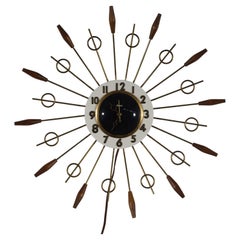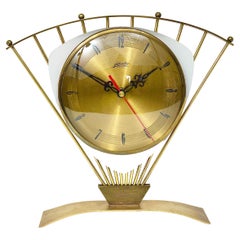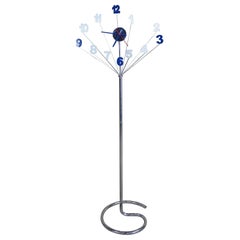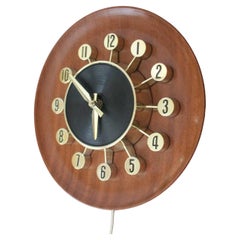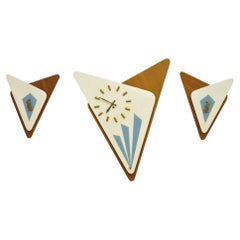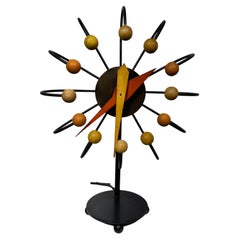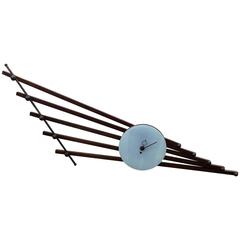Atomic Clock
Mid-20th Century American Mid-Century Modern Wall Clocks
Brass, Enamel
Mid-20th Century German Mid-Century Modern Table Clocks and Desk Clocks
Metal, Brass
Late 20th Century Mid-Century Modern More Clocks
Steel, Chrome
Mid-20th Century American Mid-Century Modern Wall Clocks
Metal
Mid-20th Century Unknown Mid-Century Modern Wall Clocks
Wood
Vintage 1950s American Mid-Century Modern Table Clocks and Desk Clocks
Metal, Iron
Vintage 1950s American Mid-Century Modern Wall Clocks
Metal
Mid-20th Century American Mid-Century Modern Wall-mounted Sculptures
Wrought Iron
Recent Sales
Vintage 1960s American Mid-Century Modern Wall Clocks
Mid-20th Century American Mid-Century Modern Table Clocks and Desk Clocks
Metal
Mid-20th Century Mid-Century Modern Wall Clocks
Wood
Vintage 1960s French Modern Wall Clocks
Brass
20th Century American Mid-Century Modern Wall Clocks
Chrome
Late 20th Century Mid-Century Modern Wall Clocks
Metal
Mid-20th Century Mid-Century Modern Wall Clocks
Brass
Mid-20th Century Mid-Century Modern Wall Clocks
Brass
Vintage 1960s Mexican Mid-Century Modern Table Clocks and Desk Clocks
Plastic
Vintage 1950s American Mid-Century Modern More Clocks
Brass, Metal
Vintage 1960s Mexican Mid-Century Modern More Desk Accessories
Plastic
20th Century American Credenzas
Wood
Vintage 1960s American Mid-Century Modern Wall Clocks
Gold Plate, Base Metal
Vintage 1960s American Mid-Century Modern Wall Clocks
Metal, Brass
Vintage 1960s Mid-Century Modern Wall Clocks
Brass
Vintage 1960s French Mid-Century Modern Wall Clocks
Metal, Brass
Vintage 1950s German Mid-Century Modern Wall Clocks
Brass
Vintage 1960s American Mid-Century Modern Table Clocks and Desk Clocks
Metal
Vintage 1950s American Mid-Century Modern Table Clocks and Desk Clocks
Metal, Brass
Vintage 1950s Japanese Mid-Century Modern More Clocks
Chrome
Vintage 1950s Unknown Mid-Century Modern Table Clocks and Desk Clocks
Steel
20th Century American Mid-Century Modern Mantel Clocks
Brass
Vintage 1950s American Mid-Century Modern Wall Clocks
Wood
Vintage 1960s German Mid-Century Modern Table Clocks and Desk Clocks
Plastic, Lucite, Plexiglass
Vintage 1950s Italian Mid-Century Modern Clocks
Brass
Vintage 1960s Unknown Mid-Century Modern Wall Clocks
Metal
Late 20th Century German Mid-Century Modern Wall Clocks
Metal, Brass
Late 20th Century German Mid-Century Modern Wall Clocks
Metal
Late 20th Century German Mid-Century Modern Wall Clocks
Metal, Brass
Mid-20th Century German Hollywood Regency Wall Clocks
Brass
Vintage 1960s American Mid-Century Modern Clocks
Vintage 1950s American Wall Clocks
Metal, Brass
Vintage 1950s American Mid-Century Modern Wall Clocks
Vintage 1950s American Wall Clocks
Stainless Steel
Vintage 1950s American Wall Clocks
Metal, Brass
Vintage 1940s Dutch Mid-Century Modern Table Clocks and Desk Clocks
Brass
People Also Browsed
21st Century and Contemporary Italian Modern Sofas
Wool, Cotton
Vintage 1960s German Mid-Century Modern Wall Clocks
Brass
Vintage 1950s American Mid-Century Modern Wall Clocks
Metal
Mid-20th Century American Mid-Century Modern Wall Clocks
Chrome
Mid-20th Century Austrian Mid-Century Modern Table Clocks and Desk Clocks
Brass
Vintage 1950s Italian Mid-Century Modern Shelves and Wall Cabinets
Brass, Steel
Vintage 1960s American Mid-Century Modern Wall Clocks
Enamel
Vintage 1980s Post-Modern Table Clocks and Desk Clocks
Metal
Vintage 1960s Czech Mid-Century Modern Wall Clocks
Metal
Mid-20th Century German Mid-Century Modern Table Clocks and Desk Clocks
Brass
Mid-20th Century German Hollywood Regency Wall Clocks
Crystal, Metal, Gold Plate
Mid-20th Century Austrian Mid-Century Modern Coat Racks and Stands
Brass
Mid-20th Century Austrian Mid-Century Modern Wardrobes and Armoires
Brass
Mid-20th Century German Mid-Century Modern Table Clocks and Desk Clocks
Brass
Atomic Clock For Sale on 1stDibs
How Much is a Atomic Clock?
A Close Look at Mid-century Modern Furniture
Organically shaped, clean-lined and elegantly simple are three terms that well describe vintage mid-century modern furniture. The style, which emerged primarily in the years following World War II, is characterized by pieces that were conceived and made in an energetic, optimistic spirit by creators who believed that good design was an essential part of good living.
ORIGINS OF MID-CENTURY MODERN FURNITURE DESIGN
- Emerged during the mid-20th century
- Informed by European modernism, Bauhaus, International style, Scandinavian modernism and Frank Lloyd Wright’s architecture
- A heyday of innovation in postwar America
- Experimentation with new ideas, new materials and new forms flourished in Scandinavia, Italy, the former Czechoslovakia and elsewhere in Europe
CHARACTERISTICS OF MID-CENTURY MODERN FURNITURE DESIGN
- Simplicity, organic forms, clean lines
- A blend of neutral and bold Pop art colors
- Use of natural and man-made materials — alluring woods such as teak, rosewood and oak; steel, fiberglass and molded plywood
- Light-filled spaces with colorful upholstery
- Glass walls and an emphasis on the outdoors
- Promotion of functionality
MID-CENTURY MODERN FURNITURE DESIGNERS TO KNOW
- Charles and Ray Eames
- Eero Saarinen
- Milo Baughman
- Florence Knoll
- Harry Bertoia
- Isamu Noguchi
- George Nelson
- Danish modernists Hans Wegner and Arne Jacobsen, whose emphasis on natural materials and craftsmanship influenced American designers and vice versa
ICONIC MID-CENTURY MODERN FURNITURE DESIGNS
- Eames lounge chair
- Nelson daybed
- Florence Knoll sofa
- Egg chair
- Womb chair
- Noguchi coffee table
- Barcelona chair
VINTAGE MID-CENTURY MODERN FURNITURE ON 1STDIBS
The mid-century modern era saw leagues of postwar American architects and designers animated by new ideas and new technology. The lean, functionalist International-style architecture of Le Corbusier and Bauhaus eminences Ludwig Mies van der Rohe and Walter Gropius had been promoted in the United States during the 1930s by Philip Johnson and others. New building techniques, such as “post-and-beam” construction, allowed the International-style schemes to be realized on a small scale in open-plan houses with long walls of glass.
Materials developed for wartime use became available for domestic goods and were incorporated into mid-century modern furniture designs. Charles and Ray Eames and Eero Saarinen, who had experimented extensively with molded plywood, eagerly embraced fiberglass for pieces such as the La Chaise and the Womb chair, respectively.
Architect, writer and designer George Nelson created with his team shades for the Bubble lamp using a new translucent polymer skin and, as design director at Herman Miller, recruited the Eameses, Alexander Girard and others for projects at the legendary Michigan furniture manufacturer.
Harry Bertoia and Isamu Noguchi devised chairs and tables built of wire mesh and wire struts. Materials were repurposed too: The Danish-born designer Jens Risom created a line of chairs using surplus parachute straps for webbed seats and backrests.
The Risom lounge chair was among the first pieces of furniture commissioned and produced by celebrated manufacturer Knoll, a chief influencer in the rise of modern design in the United States, thanks to the work of Florence Knoll, the pioneering architect and designer who made the firm a leader in its field. The seating that Knoll created for office spaces — as well as pieces designed by Florence initially for commercial clients — soon became desirable for the home.
As the demand for casual, uncluttered furnishings grew, more mid-century furniture designers caught the spirit.
Classically oriented creators such as Edward Wormley, house designer for Dunbar Inc., offered such pieces as the sinuous Listen to Me chaise; the British expatriate T.H. Robsjohn-Gibbings switched gears, creating items such as the tiered, biomorphic Mesa table. There were Young Turks such as Paul McCobb, who designed holistic groups of sleek, blond wood furniture, and Milo Baughman, who espoused a West Coast aesthetic in minimalist teak dining tables and lushly upholstered chairs and sofas with angular steel frames.
Generations turn over, and mid-century modern remains arguably the most popular style going. As the collection of vintage mid-century modern chairs, dressers, coffee tables and other furniture for the living room, dining room, bedroom and elsewhere on 1stDibs demonstrates, this period saw one of the most delightful and dramatic flowerings of creativity in design history.
Finding the Right Clocks for You
A sophisticated clock design, whether it’s a desk clock, mantel clock or large wall clock for your living room, is a decorative object to be admired in your home as much as it is a necessary functional element. This is part of the reason clocks make such superb collectibles. Given the versatility of these treasured fixtures — they’ve long been made in a range of shapes, sizes and styles — a clock can prove integral to your own particular interior decor.
Antique and vintage clocks can whisk us back to the 18th and 19th centuries. When most people think of antique clocks, they imagine an Art Deco Bakelite tabletop clock or wall clock, named for the revolutionary synthetic plastic, Bakelite, of which they’re made, or a stately antique grandfather clock. But the art of clock-making goes way back, transcending continents and encompassing an entire range of design styles and technologies. In short, there are many kinds of clocks depending on your needs.
A variety of wall clocks can be found on 1stDibs. A large antique hand-carved walnut wall clock is best suited to a big room and a flat background given what will likely be outwardly sculptural features, while Georgian grandfather clocks, or longcase clocks, will help welcome rainswept guests into your entryway or foyer. An interactive cuckoo clock, large or small, is guaranteed to bring outsize personality to your living room or dining room. For conversation pieces of a similar breed, mid-century modern enthusiasts go for the curious Ball clock, the first of more than 150 clock models conceived in the studio of legendary architect and designer George Nelson.
Minimalist contemporary clocks and books pair nicely on a shelf, but an eye-catching vintage mantel clock can add balance to your home library while drawing attention to your art and design books and other decorative objects. Ormolu clocks dating from the Louis XVI period, designed in the neoclassical style, are often profusely ornate, featuring architectural flourishes and rich naturalistic details. Rococo-style mantel clocks of Meissen porcelain or porcelain originating from manufacturers in cities such as Limoges, France, during the 18th and 19th centuries, exude an air of imperial elegance on your shelves or side tables and can help give your desk a 19th-century upgrade.
On 1stDibs, find a range of extraordinary antique and vintage clocks today.
- Do atomic clocks really work?1 Answer1stDibs ExpertApril 5, 2022Yes, atomic clocks really work. In fact, they can be very precise timekeepers. When exposed to radiation, electrons get “excited” and move. A detector in atomic clocks keeps track of the changes in atomic energy states and when it reaches a specific level, a second is ticked off. Shop a collection of atomic clocks from some of the world’s top sellers on 1stDibs.
Read More
How Noguchi Elevated Ashtrays to Objets d’Art
Smoking might have fallen out of fashion, but these ashtrays have enduring design appeal.
Jeff Andrews Captures Old Hollywood Glamour in His Cinematic Spaces
Having created extravagant homes for reality TV’s biggest stars, the designer is stepping into the spotlight with his first book.
Tapio Wirkkala Bucked the Trends of Mid-Century Nordic Design
The Finnish talent created nature-inspired pieces, from furniture to jewelry, with phenomenal staying power.
